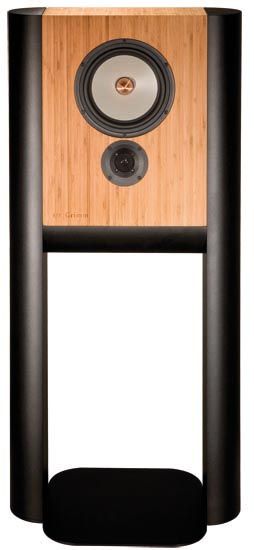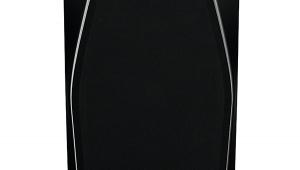Grimm Audio Ls1 (€10,000)
 So, Grimm Audio is not the most propitious name, in English, for a hi-fi manufacturer. But once the schoolboy giggles have subsided, there are two very good reasons to take this Dutch company, and its new LS1 loudspeaker, seriously.
So, Grimm Audio is not the most propitious name, in English, for a hi-fi manufacturer. But once the schoolboy giggles have subsided, there are two very good reasons to take this Dutch company, and its new LS1 loudspeaker, seriously.
Firstly, there are the people involved. The second reason is the LS1 itself, because run-of-the-mill it is not. In addition to being active it has onboard DSP to perform crossover filtering, equalisation and time alignment of the two drivers, making it one of a very small number of audiophile loudspeakers to have exploited digital signal processing thus.
As you’ll gather from the photographs, it isn’t only this which makes the LS1 unusual. It looks odd with its wide baffle, inverted driver arrangement and half-round extruded aluminium sections, running along the lower edge and to either side of the shallow cabinet, where they also form the speaker’s stand and house the electronics. All these features illustrate ‘form following function’.
Let’s begin with that wide baffle. We’re so habituated today to narrow front baffles that it’s natural to presume this is the optimum arrangement. Well, Grimm Audio demurs. It’s an issue of directivity – how the loudspeaker radiates sound around it. If you want a speaker to have as wide a directivity as possible then you give it a narrow baffle, whereas if you want to narrow its directivity as quickly as possible with rising frequency you use a wider baffle. Which is precisely what Grimm Audio has chosen to do with the LS1 because it reduces the strength of the first side wall reflections, and thereby – it is hoped – the room’s influence.
Because the cabinet is wide (358mm across the baffle, 522mm overall) it is also – in order to present the required internal volume to the bass-mid driver – unusually shallow (160mm externally). This has the further advantage of raising the front-to-back internal air resonance to a frequency above the working range of the bass-mid driver. But it also means there is little opportunity to absorb the reflection from the cabinet back wall, some of which will find its way out through the cast magnesium cone of the 220mm SEAS Excel bass-mid driver.
REDUCING DIFFRACTION
In passive speakers an inverted arrangement of bass-mid unit (top) and tweeter (below) is used to equalise the path lengths from each driver to the listener’s ears. But the LS1’s tweeter is below its bass-mid driver, to allow the third piece of half-round extrusion to be fitted along the bottom edge of the cabinet rather than along the top edge, where it would look more awkward and demand a mitre joint to the two side sections. It’s there for the same reason they are: to smooth the change in acoustic impedance that occurs at the baffle edge and so minimise the diffraction effects that result.
DSP is used to correct frequency domain behaviour only, in respect of both amplitude and phase. Crossover between the two drivers is by fourth-order Linkwitz-Riley slopes, the filters being computationally efficient IIR (infinite impulse response) types with an FIR (finite impulse response) all-pass filter to correct their phase distortion. Equalisation is by IIR filters too, and very simple, low-Q ones at that: only those trends that are present in both the on-axis and off-axis responses being corrected. The EQ is generic, rather than adjusted for each individual speaker, the tight production tolerances of the SEAS drivers ensuring that overall frequency response remains flat within tight limits.
Onboard A-to-D conversion allows analogue signal sources to be connected but for this review a digital source was used exclusively via one of the LS1’s two balanced digital inputs, which are also compatible with unbalanced S/PDIF feeds via an adaptor cable. Signal connection is made to one of the speakers only, a supplied cable carrying the signal to the second speaker via 8P8C (RJ45) sockets. Each speaker knows which channel to reproduce by appropriate setting of a small toggle switch. Also connected to the first speaker, by a short RJ45 link, is a wired remote control that also houses a receiver for an IR remote handset (not supplied). A rotary control atop the wired remote provides both input selection and volume control, the gain setting appearing as two digits in the display on the remote’s front face.
UNUSUAL TOE-IN
Eelco Grimm and Guido Tent delivered and set up the LS1s in my listening room, and when they’d finished, the speaker layout was as unusual as the LS1s themselves. Designed to be listened to at 15 degrees off-axis horizontally, these speakers are intended to be toed-in such that their axes cross some way in front of the listener, with two potential benefits. First, less sound is fired at the nearest side wall; and second, time-intensity trading (whereby the further speaker gets louder as you move to either side of the optimum listening position) enlarges the acceptable listening area. As John Crabbe showed many years ago in these pages, achieving effective time-intensity trading requires a much more directional output than supplied by the LS1, but Grimm’s philosophy is that some is better than none. As you can imagine, I played with other, more conventional speaker positions just as soon as the LS1’s minders had left, but eventually had to concede that having the speakers widely spaced and overly toed-in did indeed provide the best results.
It’s natural to expect of a speaker with DSP crossovers and EQ, an unusually flat frequency response, and recording and mastering studios as one target audience, that it should sound neutral to the point of being clinical. That, after all, is what we’ve come to expect from a generation of studio monitors. But the LS1 doesn’t fit this mould. Its flat response endows it with unusual tonal neutrality, no question, and the recommended positioning creates a super-wide stereo image in which the position of every musical strand is meticulously controlled. Yet there is something softened, something less than ruthlessly explicit, about the sound overall. A symptom of this was that I kept finding myself using higher than usual replay levels, attempting to put back what I felt was missing.
A TOUCH TOO EMOLLIENT
I am not, by any means, a devotee of Paul McCartney’s post-Beatles work so I might well have gone my whole life not possessing a copy of Band On The Run, but for the fact that it recently became available in 24/96 form from HD tracks, and inquisitiveness got the better of me. Track 11, ‘Country Dreamer’, begins with a distinctly distorted acoustic guitar in the right channel, followed by sliding bass left of centre, then, eventually, Macca’s first vocal refrain. After 57 seconds, at the start of the second stanza – ‘I’d like to stand in a stream with you’ – the vocal quality hardens: markedly enough to make you wince slightly when listening to a warts and all, high transparency system. Via the LS1s (fed via the balanced digital outputs of a TC Electronic Digital Konnekt x32 professional FireWire audio interface from my Mac mini, running Windows XP and using J River Media Center v15 as the player software) this change in vocal character was blunted. It was still there if you listened for it, of course, but less self-evident.
As a complete musical contrast I chose Anton Webern’s spiky ‘Rasch’, one of the short movements from his Four Pieces for Violin and Piano (from ‘Mirror Canon’, 2L Records 24/96 download), the quintessence of which is a restless, unsettled – and unsettling – energy. This piece thrives on precision for its impact, in both the playing and the replaying, and isn’t supposed to sound in the least bit cosy. Quite the opposite: it’s a musical astringent that should put your senses on edge, otherwise the intended effect is lost.
Via the LS1s, that vital precision was lacking. Dynamics and even image focus were a little blurred; a piece of music that should really sock you between the eyes became a touch too emollient.
Of course, for some listeners this refusal by the LS1 to make unpleasant noises will be a positive attribute. If you like a big sound that errs on the side of caution, this speaker has much to commend it. But if you demand the unvarnished, sometimes harsh, truth, you should probably look elsewhere.
VERDICT
I hope this is just the first speaker product from Grimm Audio because the world needs more of the original thinking and active/DSP design that it embodies. Its sonic strengths are an unusually even tonal balance and, when set up as intended, a wide, deep stereo soundstage: attributes that will endear it to many. All it lacks are the hear-through transparency and whip-crack dynamic alacrity of a true great.
Originally published in the March 2011 issue


























































